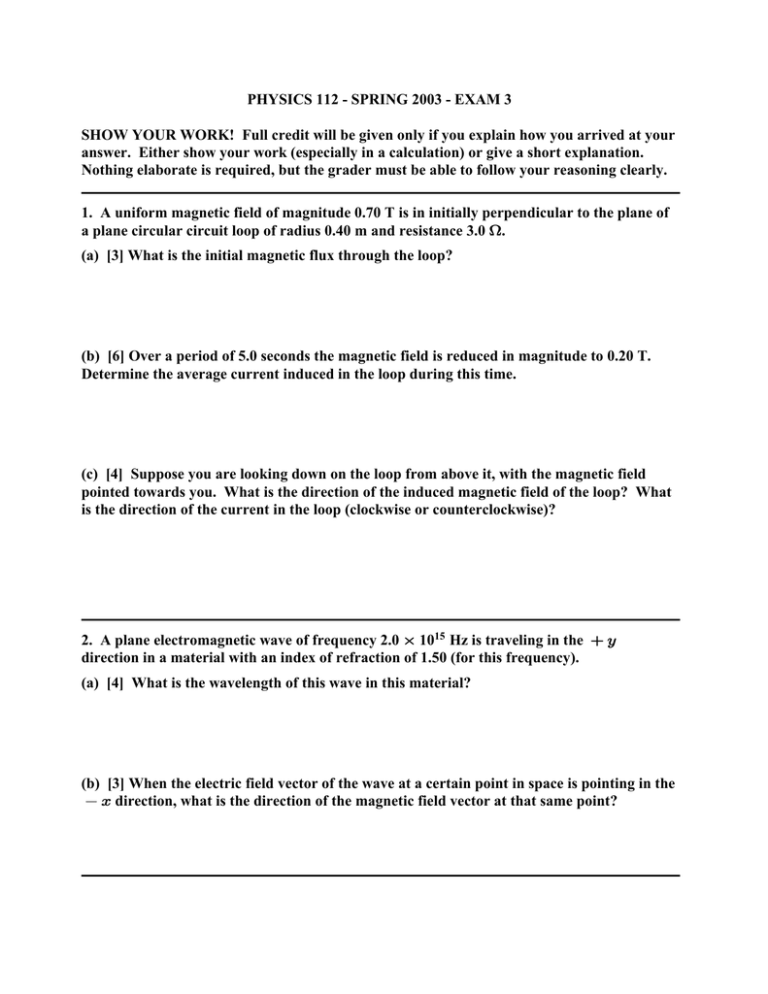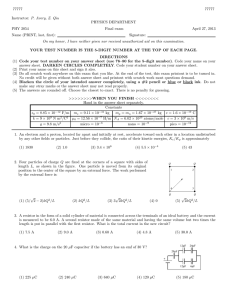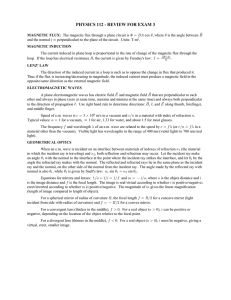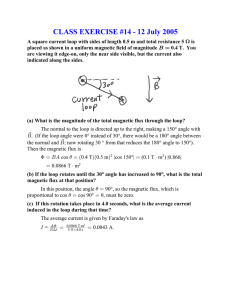PHYSICS 112 - SPRING 2003 - EXAM 3
advertisement

PHYSICS 112 - SPRING 2003 - EXAM 3 SHOW YOUR WORK! Full credit will be given only if you explain how you arrived at your answer. Either show your work (especially in a calculation) or give a short explanation. Nothing elaborate is required, but the grader must be able to follow your reasoning clearly. 1. A uniform magnetic field of magnitude 0.70 T is in initially perpendicular to the plane of a plane circular circuit loop of radius 0.40 m and resistance 3.0 H. (a) [3] What is the initial magnetic flux through the loop? (b) [6] Over a period of 5.0 seconds the magnetic field is reduced in magnitude to 0.20 T. Determine the average current induced in the loop during this time. (c) [4] Suppose you are looking down on the loop from above it, with the magnetic field pointed towards you. What is the direction of the induced magnetic field of the loop? What is the direction of the current in the loop (clockwise or counterclockwise)? 2. A plane electromagnetic wave of frequency 2.0 ‚ 1015 Hz is traveling in the C direction in a material with an index of refraction of 1.50 (for this frequency). (a) [4] What is the wavelength of this wave in this material? (b) [3] When the electric field vector of the wave at a certain point in space is pointing in the B direction, what is the direction of the magnetic field vector at that same point? 3. [10] A light ray is incident onto an interface between two different materials at an angle of 30° to the normal at that point. Suppose, as shown, that the ray is incident in a material with 8 œ 1.80 and the other side of the interface has 8 œ 1.20, striking at the point where the dot is. Show the normal to the interface and that point. Determine the directions of the reflected and refracted rays and sketch them approximately to scale on the diagram. 8 œ 1.80 . 8 œ 1.20 For this situation, what is the critical angle of incidence for total internal reflection, i.e., the smallest angle of incidence for which there is no refracted ray? . 4. An object is located on the principal axis of a divergent lens at a a distance of 6.0 cm from the lens. The lens has a focal length 0 œ 3.0 cm. (a) [3] Sketch a diagram of this lens system and use ray tracing (at least two rays) to locate the image. (b) [6] Use the lens equation to determine the image distance and the magnification. (c) [1] Characterize the image as real or virtual and as erect or inverted. PHYSICS 112 - SPRING 2003 - EXAM 3 - Problems with Solutions SHOW YOUR WORK! Full credit will be given only if you explain how you arrived at your answer. Either show your work (especially in a calculation) or give a short explanation. Nothing elaborate is required, but the grader must be able to follow your reasoning clearly. 1. A uniform magnetic field of magnitude 0.70 T is in initially perpendicular to the plane of a plane circular circuit loop of radius 0.40 m and resistance 3.0 H. (a) [3] What is the initial magnetic flux through the loop? The initial magnetic flux is F œ FE cos ) œ Ð0.70 TÑÐ1ÑÐ0.40 mÑ2 cos 0° œ 0.35 T † m2 Þ (b) [6] Over a period of 5.0 seconds the magnetic field is reduced in magnitude to 0.20 T. Determine the average current induced in the loop during this time. The average induced current in the loop is M œ Ð?FÎ?>ÑÎV œ Ecos 0°Ð?FÎ?>ÑÎV œ 1(0.40 m)2 (1)( 0.50 T/ 5.0 s)/ 3.0 H œ 0.017 A. The current has magnitude 0.017 A. (c) [4] Suppose you are looking down on the loop from above it, with the magnetic field pointed towards you. What is the direction of the induced magnetic field of the loop? What is the direction of the current in the loop (clockwise or counterclockwise)? The external magnetic field is decreasing in magnitude, so the induced current in the loop will be such as to give an induced magnetic field in the same direction as the external magnetic field (to counteract its decrease). This means the current will appear counterclockwise as you look down from above, with the external magnetic field pointed towards you. 2. A plane electromagnetic wave of frequency 2.0 ‚ 1015 Hz is traveling in the C direction in a material with an index of refraction of 1.50 (for this frequency). (a) [4] What is the wavelength of this wave in this material? - œ @Î0 œ Ð-Î8ÑÎ0 œ -Î80 œ Ð3 ‚ 108 m/sÑÎÐ1.50ÑÐ2.0 ‚ 1015 HzÑ œ 1.0 ‚ 107 m or 100 nm. (b) [3] When the electric field vector of the wave at a certain point in space is pointing in the B direction, what is the direction of the magnetic field vector at that same point? Using the right-hand rule: forefinger (direction traveling) along C, middle finger (direction of electric field) along B, then thumb (direction of magnetic field) is along D . 3. [10] A light ray is incident onto an interface between two different materials at an angle of 30° to the normal at that point. Suppose, as shown, that the ray is incident in a material with 8 œ 1.80 and the other side of the interface has 8 œ 1.20, striking at the point where the dot is. Show the normal to the interface and that point. Determine the directions of the reflected and refracted rays and sketch them approximately to scale on the diagram. 8 œ 1.80 . 8 œ 1.20 The reflected ray is also at 30° from the normal, on the opposite side of the normal from the incident ray. The refracted ray is in the other material, also on the opposite side of the normal from the incident ray, at an angle given by Snell's law: 1.80 sin 30° œ 1.20 sin )2 so sin )2 œ (1.80)(sin 30°)/1.20 œ 0.75 so )2 œ 48.6°Þ For this situation, what is the critical angle of incidence for total internal reflection, i.e., the smallest angle of incidence for which there is no refracted ray? This is the angle for which the refracted ray is at 90 °: 1.80 sin )c œ 1.20 sin 90° or sin )c œ 1.20/1.80 œ 0.667 so )c œ 41.8° . 4. An object is located on the principal axis of a divergent lens at a a distance of 6.0 cm from the lens. The lens has a focal length 0 œ 3.0 cm. (a) [3] Sketch a diagram of this lens system and use ray tracing (at least two rays) to locate the image. The rays from the object diverge on the other side of the lens, and appear to come from an image about 1/3 of the way from the lens back to the object's location. (b) [6] Use the lens equation to determine the image distance and the magnification. The lens equation is 1/9 1/3 œ 1/0 so 1/3 œ 1/0 1/9 œ 1/( 3.0 cm) 1/(6.0 cm) œ 3.0/6.0 cm œ 1/2.0 cm and thus 3 œ 2.0 cm. The magnification is then 7 œ 3Î9 œ Ð 2.0 cmÑÎÐ6.0 cmÑ œ 1/3 or 0.33. (c) [1] Characterize the image as real or virtual and as erect or inverted. The image is virtual (because 3 is negative) and erect (because 7 is positive). It is also smaller than the object (1/3 as tall).







